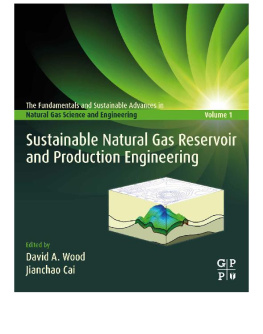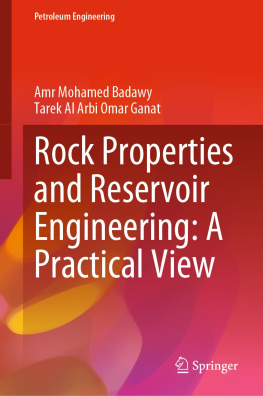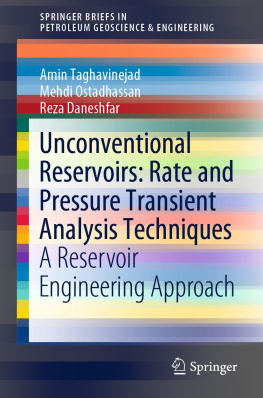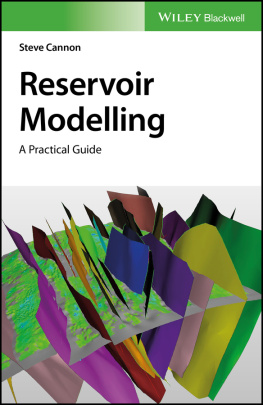Advanced Petroleum Reservoir Simulation
Scrivener Publishing
100 Cummings Center, Suite 541J
Beverly, MA 01915-6106
Publishers at Scrivener
Martin Scrivener ()
Phillip Carmical ()
Copyright 2016 by Scrivener Publishing LLC. All rights reserved.
Co-published by John Wiley & Sons, Inc. Hoboken, New Jersey, and Scrivener Publishing LLC, Salem, Massachusetts.
Published simultaneously in Canada.
No part of this publication may be reproduced, stored in a retrieval system, or transmitted in any form or by any means, electronic, mechanical, photocopying, recording, scanning, or otherwise, except as permitted under Section 107 or 108 of the 1976 United States Copyright Act, without either the prior written permission of the Publisher, or authorization through payment of the appropriate per-copy fee to the Copyright Clearance Center, Inc., 222 Rosewood Drive, Danvers, MA 01923, (978) 750-8400, fax (978) 750-4470, or on the web at www.copyright.com . Requests to the Publisher for permission should be addressed to the Permissions Department, John Wiley & Sons, Inc., 111 River Street, Hoboken, NJ 07030, (201) 748-6011, fax (201) 748-6008, or online at http://www.wiley.com/go/permission .
Limit of Liability/Disclaimer of Warranty: While the publisher and author have used their best efforts in preparing this book, they make no representations or warranties with respect to the accuracy or completeness of the contents of this book and specifically disclaim any implied warranties of merchantability or fitness for a particular purpose. No warranty may be created or extended by sales representatives or written sales materials. The advice and strategies contained herein may not be suitable for your situation. You should consult with a professional where appropriate. Neither the publisher nor author shall be liable for any loss of profit or any other commercial damages, including but not limited to special, incidental, consequential, or other damages.
For general information on our other products and services or for technical support, please contact our Customer Care Department within the United States at (800) 762-2974, outside the United States at (317) 572-3993 or fax (317) 572-4002.
Wiley also publishes its books in a variety of electronic formats. Some content that appears in print may not be available in electronic formats. For more information about Wiley products, visit our web site at www.wiley.com .
For more information about Scrivener products please visit www.scrivenerpublishing.com .
Library of Congress Cataloging-in-Publication Data:
ISBN 978-1-119-03851-1
Authors would like to dedicate this book to their teacher and grand teacher, Professor S.M. Farouq Ali, Encana/Petroleum Society Chair Professor at the University of Calgary.
Preface
The Information Age is synonymous with an overflow, a superflux, of information. Information is necessary for traveling the path of knowledge, leading to the truth. Truth sets one free; freedom is peace.
Yet, here a horrific contradiction leaps out to grab one and all by the throat: of all the characteristics that can be said to characterize the Information Age, neither freedom nor peace is one of them. The Information Age that promised infinite transparency, unlimited productivity, and true access to Knowledge (with a capital-K, but, quite distinct from know-how), requires a process of thinking, or imagination the attribute that sets human beings apart.
Imagination is necessary for anyone wishing to make decisions based on science. Imagination always begins with visualization actually, another term for simulation. Any decision devoid of a priori simulation is inherently aphenomenal. It turns out simulation itself has little value unless fundamental assumptions as well as the science (time function) are actual. While the principle of garbage in and garbage out is well known, it only leads to using accurate data, in essence covering the necessary condition for accurate modeling.
The sufficient condition, i.e., the correct time function, is little understood, let alone properly incorporated. This process of including continuous time function is emulation and is the principal theme of this book. The petroleum industry is known as the biggest user of computer models. Even though space research and weather prediction models are robust and often tagged as the mother of all simulation, the fact that a space probe device or a weather balloon can be launched while a vehicle capable of moving around in a petroleum reservoir cannot makes reservoir modeling more challenging than in any other discipline.
This challenge is two-fold. First, there is a lack of data and their proper scaling up. Second is the problem of assuring correct solutions to the mathematical models that represent the reservoir data. The petroleum industry has made tremendous progress in improving data acquisition and remote-sensing ability. However, in the absence of proper science, it is anecdotally said that a weather model of Alaska can be used to simulate a petroleum reservoir in Texas. Of course, pragmatism tells us, well come across desired outcome every once in a while, but is that anything desirable in real science? This book brings back real science and solves reservoir equations with the entire history (called the memory function) of the reservoir. The book demonstrates that a priori linearization is not justified for the realistic range of most petroleum parameters, even for single-phase flow. By solving non-linear equations, this book gives a range of solutions that can later be used to conduct scientific risk analysis.
This is a groundbreaking approach. The book answers practically all questions that emerged in the past. Anyone familiar with reservoir modeling would know how puzzling subjective and variable results something commonly found in this field can be. The book deciphers variability by accounting for known nonlinearities and proposing solutions with the possibility of generating results in cloud-point forms. The book takes the engineering approach, thereby minimizing unnecessary complexity of mathematical modeling. As a consequence, the book is readable and workable with applications that can cover far beyond reservoir modeling or even petroleum engineering.
Chapter 1
Introduction
1.1 Summary
It is well known that reservoir simulation studies are very subjective and vary from simulator to simulator. While SPE benchmarking has helped accept differences in predicting petroleum reservoir performance, there has been no scientific explanation behind the variability that has frustrated many policy makers and operations managers and puzzled scientists and engineers. In this book, a new approach is taken to add the Knowledge dimension to the problem. Some attempted to correct this shortcoming by introducing history matching, often automatizing the process. This has the embedded assumption that outcome justifies the process the ultimate of the obsession with externals. In this book, reservoir simulation equations are shown to have embedded variability and multiple solutions that are in line with physics rather than spurious mathematical solutions. With this clear description, a fresh perspective in reservoir simulation is presented. Unlike the majority of reservoir simulation approaches available today, the knowledge-based approach does not stop at questioning the fundamentals of reservoir simulation but offers solutions and demonstrates that proper reservoir simulation should be transparent and empower decision makers rather than creating a black box. For the first time, the fluid memory factor is introduced with a functional form. The resulting governing equations become truly non-linear. A series of clearly superior mathematical and numerical techniques are presented that allow one to solve these equations without linearization. These mathematical solutions that provide a basis for systematic tracking of multiple solutions are emulation instead of simulation. The resulting solutions are cast in cloud points that form the basis for further analysis with advanced fuzzy logic, maximizing the accuracy of unique solution that is derived. The models are applied to difficult scenarios, such as in the presence of viscous fingering, and results compared with experimental data. It is demonstrated that the currently available simulators only address very limited range of solutions for a particular reservoir engineering problem. Examples are provided to show how the Knowledge-based approach extends the currently known solutions and provide one with an extremely useful predictive tool for risk assessment.









